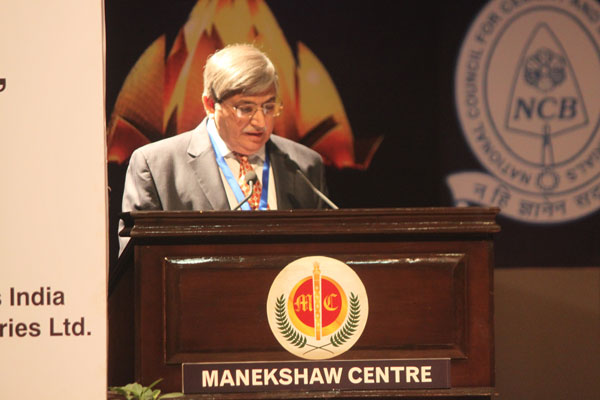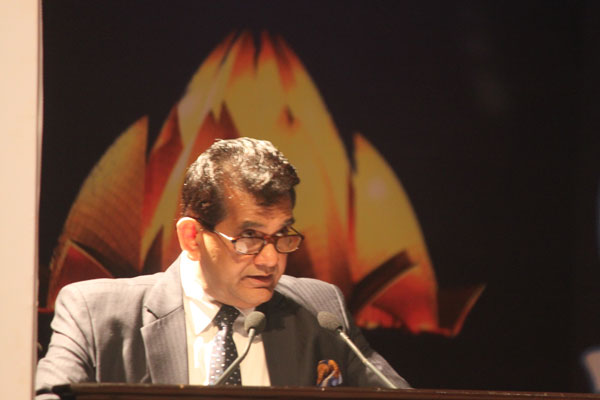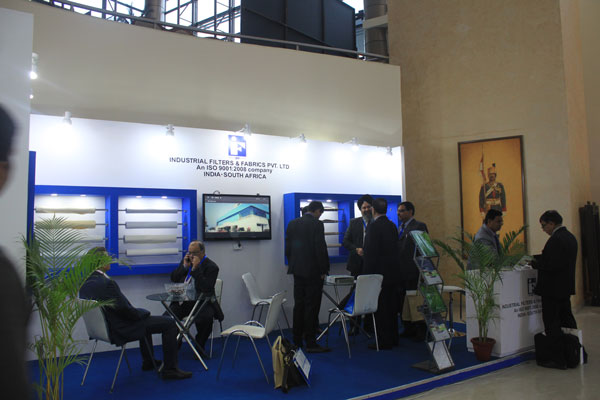14th NCB International Seminar
The 14th NCB International Seminar on Cement and Building Materials in New Delhi, India, held on 1-4 December 2015, saw a gathering of more than 1000 delegates and plenty of avid discussion on how the Indian cement sector should move forward to meet expected rises in demand and foster sustainable production.

Ashwani Pahuja, NCB director general, outlines the main factors
that are central to the development of the Indian cement industry
The inaugural session of the 14th NCB International Seminar on Cement and Building Materials, held in the Zorawar Auditorium of the Manekshaw Centre, New Delhi, reflected some of the most prominent views about the future direction of the Indian cement sector and the difficulties it faces.
RK Goswami, NCB general manager, greeted guests and outlined the meeting’s aims: “I would like to emphasise that the objective of the NCB seminar has always been to exchange experiences and to devise guidelines and strategies for the development of the cement industry.”
The event included five days of technical papers and workshops, plus an international equipment exhibition featuring 90 suppliers and consultants to the cement industry. Proceedings also marked the launch of NCB’s latest publication: “Cement & Construction Industry – Perspectives for Sustainable Growth”.
Pursuing higher economic growth rates
Delivering the inaugural address, Amitabh Kant, secretary, Department of Industrial Policy and Promotion, Government of India, spoke of the need to accelerate the country’s economic growth rate: “India is growing at the rate of about 7.5 per cent per annum. The challenge is to accelerate this pace and to take it to 9 or 10 per cent per annum, year after year for the next three decades or more, to lift a large segment of the population that currently lives below the poverty line.
“India is passing through a window of demographic transition which rarely happens in history. Seventy-two per cent of our population is below the age of 32 and the challenge that India must grow is the single-minded pursuit that India must have. India must have ambition. India must be hungry for growth.”
Urban awakening
The rapid urbanisation that is forecast to take hold over the next two decades presents both obstacles and opportunities for the country. Mr Kant noted that by 2030 some 350m people are expected to move from the country’s rural areas to cities. And this process is expected to continue beyond that date. Quoting McKinsey & Co’s latest report on India, he added that some 700m of the country’s population are forecast to become part of this urbanisation process by 2050. “This means India’s challenge is to create two-and-a-half Americas. And every minute that I speak today, there are 30 Indians moving from rural to urban areas. Therefore, the biggest challenge for India is to urbanise.”

Amitabh Kant, secretary for the Department of Industrial Policy and Promotion, Government of India, explains
during his inaugural address that while rapid urbanisation is considered one of India’s biggest challenges, it also
presents plenty of opportunities – not least for the domestic cement industry
This bodes well for the domestic cement industry as it is likely to be a major beneficiary of such urban awakening. “Our focus is on concrete roads and housing for all by 2022 and development of 100s of smart cities and dedicated freight corridors, linking cities such as Mumbai and New Delhi. Connectivity improvements include water transport, and an enormous boost to infrastructure is expected,” underlined Mr Kant.
Cement consumption confidence climbs
Presently, the domestic demand environment remains been weak, but confidence is building that a demand revival could be ahead. Acknowledging the struggles the Indian cement industry has been facing in terms of lacklustre market growth rates, Ajay Kapur, CEO of Ambuja Cements said: “At the moment the [domestic] cement industry is in the middle of challenging times, faced with relatively low consumption and growth rates. This has not been something we have known in the recent past. For us, a 10 per cent growth rate was almost taken for granted.
“We expect cement demand to catch up with the improved GDP. I also expect that cement demand would enjoy a compounded growth rate of 7-8 per cent in the next couple of years. And we could see 425Mt of cement demand in the country by 2020.”
Mr Kapur also emphasised the importance of exploring new regional and external markets: “The eastern states of India along with the border states are the new untapped markets for several cement companies. “I am quite sure that in the near future India will be well positioned to become a main exporter of clinker and cement to various countries, including our neighbours.”
Facilitating the five Rs
As the second-largest producer in the world behind China, India has an installed cement capacity of 390Mta and a production of 370Mta. With domestic demand expected to surpass the 400Mt mark by 2020, the growing thirst for cement is expected to present several challenges to the industry on the production and sustainability front.
According to Ashwani Pahuja, director general of the NCB: “The goal of the Indian cement industry in the present, competitive, carbon- and resource-constrained and environmentally-conscious scenario is based on the five-word concept: recycle, recover, reuse, rethink and recreate. Minimising carbon emissions, economic prosperity and environmental stewardship, and social responsibility are central to the development of the country’s cement sector.”
Mr Pahuja also highlighted the exemplary role of the Indian cement industry across the global stage. “Presently, the cement companies in India are building global capacities, more modern plants, improving efficiencies, cutting costs and restructuring their businesses to become highly competitive. In fact, the world is looking towards India having set the benchmarks for the most energy-efficient plants as well as for the most productive units coming out of India.”

The seminar was accompanied by an equipment exhibition in which more than 90 companies participated
Towards a circular economy
With domestic demand expected to surpass the 400Mt mark by 2020, Mr Pahuja stressed the need for increased exploration intensity and a drive toward a circular economy, as well as a raft of other issues, including alternative fuel use, rail logistics and new emission legislation.
Concerns over depleting raw material reserves present a particular challenge. “In view of the rapidly-dwindling raw material resources, it is imperative that intensive research be conducted to develop new products depending on the availability of resources. This should be towards the direction of blended types like composite cements and Portland limestone cements which are already in use in European countries and need to be adopted, standardised and produced in India,” Mr Pahuja stressed.
“Efforts in the recent past have been directed towards this, producing more sustainable cements and reducing the clinker factor of cement. Based on the detailed investigations carried out by the NCB, many waste materials like lead-zinc slag and copper slag have been recommended by the Bureau of Indian Standards for placement as performance improvers in cements,” he informed delegates.
He advocated the need to work towards a circular economy, with zero emissions and closed-loop production processes that minimise the need for newly-quarried raw materials and place reuse, recycling and recovery at the centre of cement production.
These concepts would also extend to the construction of durable infrastructure as part of the government’s Smart Cities initiative, he continued.
Alternative fuel usage and waste management solutions
Mr Pahuja also spoke about the importance of raising alternative fuel usage and government support for such efforts. “Although alternative fuel usage in India started about a decade ago, today we have not been able to harness more than one per cent of that total energy recovery or substitution compared to the developed nations that record around 40 per cent. Co-processing is not a self-sustaining option on its own as it depends on government support.
“In developed countries a system of waste collection, preprocessing and supply has matured over the years and is based on the principle of ‘polluter pays’. In fact, some of the plants in developing countries have reported negative fuel costs as a result of the co-processing application.
“Therefore, collective policies in this regard are needed urgently to augment substitution rates in Indian cement plants through effective policy measures.”
This view was also supported by Ambuja Cement’s Mr Kapur who stated: “I am positive that the cement industry can provide a modern and sustainable waste management solution.” He called upon the government to support the initiative with policies to promote use of materials such as fly ash and slag. To reduce waste and promote alternative fuel use as a viable disposal option, the principle of ‘polluters pay’ and approval procedures need to be adequately implemented, he added.
Fuel challenges
Mr Kapur further commented on measures that could be instilled to overcome fuel issues. Challenges currently being faced by Indian cement producers include a shortage of coal linkages, securing fuel sources and perennial constraints such as high ash content and the erratic variation in the quality of domestic coal. “The cement sector receives around 26 per cent of its coal requirement through FSA [Fuel Supply Agreements], forcing it to meet the balance of 74 per cent fuel requirement from costlier imported coal, e-option petcoke and alternative fuels.” The government could play a key role in alleviating the issue to a great extent if it were to grant equal priority in granting the coal linkages to the cement industry as well as reserving sufficient blocks for cement producers, he added.
Reduced energy consumption
In terms of reducing energy consumption, Mr Kapur stated: “Cement plants have achieved a present average thermal energy consumption of 725kcal/kg of clinker and an average electrical energy consumption of 78kWh/t of cement. However, there are plants in India that are achieving even 686kcal/kg of clinker and 68kWh/t of cement.
“Captive power in India has increased substantially from 180MW in 1982 to the present level of about 5000MW, which has resulted in a production of 60 per cent of cement from our own captive resources. The cement industry is also setting up power generation units using radial forms of energy like solar and wind. Today we have 250MW of capacity from wind turbines. This will contribute to the national targets of 175GW.”
Rail logistics
Rail logistics is another bottleneck for the cement industry. Deeming the current situation unviable, Mr Kapur said: “The share of rail has dropped to 34 per cent from 54 per cent a few years back, due to absence of even basic infrastructure and facilities at terminals and non-availability of wagons at peak times for cement and clinker.”
New emissions legislation
The new laws for NOx, SOx and particulate matter emissions present an additional obstacle.
Amitabh Kant advocated the view that to further reduce CO2 emissions, the industry should employ the five levers that have been identified in the NCB-CMA (Cement Manufacturers’ Association of India) technology roadmap:
• reduced clinker factor
• increased use of alternative fuels and raw materials
• improvement of thermal and electrical energy efficiency
• recovery of waste heat
• application of newer technologies.
He highlighted the recent advances made by the Indian cement industry in terms of lowering the clinker factor and hence, the carbon footprint of domestically-produced cement: “The present production of blended cements in the country has been around 72 per cent as against only 36 per cent in 2000-01 and consuming about 28 per cent of the total fly ash generated and the entire quantity of ground blast furnace slag – the waste produced by steel plants exceeding 10Mta. Accordingly, the current clinker factor has been reduced down to a carbon footprint of 0.77CO2/t. If we focus on it, we can achieve the target of 0.582CO2/t by 2020 and 0.35CO2/t by 2050.”
Building market momentum
During his presidential address, Dr S Choukesy, director of JK Lakshmi Cement and vice chairman of the NCB’s Board of Governors, highlighted the positive outlook for the industry, particularly in light of the government’s development initiatives: “The outlook is very positive due to the development programme being initiated by the government, especially as the ‘Make in India’ campaign will provide the required momentum for the cement market.”
Article first published in International Cement Review, February 2016.

